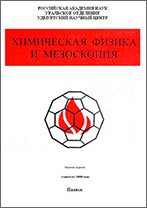|
|
Chemical Physics and Mesoscopics, 2017, Volume 19, Issue 1, Pages 5–19
(Mi chphm318)
|
|
|
|
This article is cited in 1 scientific paper (total in 1 paper)
Modeling of smoke oxide particles evolution in flow of combustion products of aluminized solid propellant
V. A. Babuk, N. L. Budnyi
Baltic State Technical University "VOENMEH", St. Petersburg, Russia
Abstract:
The article presents results of development and testing of mathematical model of smoke oxide particles evolution in one-dimensional flow of aluminized solid propellants combustion products. Main phenomenon, which occurs during evolution, is decreasing of oxide particles dispersity. It is assumed that main mechanism of this phenomenon is condensation of aluminum oxides (which are produced during agglomerate metal burning) on surface of smoke oxide particles and its coagulation. The following physical picture was proposed. There is a multiphase heterogeneous flow of solid propellant combustion products; burning agglomerates has a velocity lag relative to gas phase with smoke oxide particles. This situation leads to inflow of smoke oxide particles into zones of vapor-phase agglomerate burning. «Captured» smoke oxide particles act as a nuclei in process of heterogeneous condensation of aluminum oxides and condensed Al$_2$O$_3$ formation, which leads to enlargement of smoke oxide particles. It is assumed that coagulation of these particles is also possible. Developed model is based on several sub-models: model of smoke oxide particles formation during burning of agglomerate metal, model of agglomerates and gas phase evolution. It should be noted that agglomerate evolution model was verified for wide range of propellants and combustion conditions. Stochastic distribution of agglomerates in arbitrary section of one-dimensional flow and stochastic behavior of smoke oxide particles spatial redistribution significantly complicate determination of nuclei distribution at the «inlet» of agglomerate burning zone. This circumstance leads to complexity of simulation of smoke oxide particles evolution. Special approach was developed to overcome this complication. It was assumed that there is a length of spatial interval (called L$_{inv}$) where all smoke oxide particles from initial section are involved in interaction with agglomerates. Hence, nuclei distribution for any agglomerate within Linv is a smoke oxide particles distribution from the initial section. Those spatial intervals initially measured from burning surface of propellant and further from subsequent section. Main idea of developed model is discretization of one-dimensional computational domain on spatial intervals and application of named sub-models to describe evolution of gas phase, agglomerates and smoke oxide particles within each interval. Length of each spatial interval equals to L$_{inv}$. It is assumed that L$_{inv}$ for each case depends on sum of agglomerates midsections per unit volume, mean gas phase velocity and mean agglomerates velocity lag relative to gas phase. This dependence was obtained by matching numerical results with experimental data. A comparison criterion is a matching of numerical and experimental mass-mean diameter of smoke oxide particles at the exit of protective tube (element of experimental setup). It is shown that the obtained dependence has universal character and can be used for any conditions and propellants. Comparison of numerical and experimental results is presented and it allows to draw a conclusion about rightness of main principles of developed model. Results of present article allows to predict smoke oxide particles dispersity in arbitrary section of one-dimensional combustion products flow with known smoke oxide particles parameters at the propellant burning surface.
Keywords:
solid propellant, condensed combustion products, condensation, coagulation, smoke oxide particles, agglomerates, modeling.
Linking options:
https://www.mathnet.ru/eng/chphm318
|

| Statistics & downloads: |
| Abstract page: | 17 |
|




 Contact us:
Contact us: Terms of Use
Terms of Use
 Registration to the website
Registration to the website Logotypes
Logotypes







